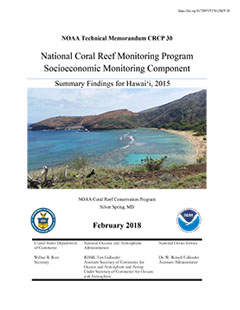-
Home
-
Data & Publications
-
Regional Portals
- About Regional Portals
- Florida
- Navassa Island
- Puerto Rico
- Flower Garden Banks
- U.S. Virgin Islands
- American Samoa
- Commonwealth of the Northern Mariana Islands
- Federated States of Micronesia
- Guam
- Main Hawaiian Islands
- Republic of the Marshall Islands
- Northwestern Hawaiian Islands
- Republic of Palau
- Pacific Remote Island Areas
-
CRCP Activities
- Glossary
National Coral Reef Monitoring Program Socioeconomic Monitoring Component: Summary Findings for Hawai'i, 2015

The Socioeconomic Component of the National Coral Reef Monitoring Program (NCRMP) is currently in the process of monitoring socioeconomic indicators across all U.S. coral reef territories and jurisdictions. These indicators include the demographics of these areas, human use of coral reef resources, as well as knowledge, attitudes, and perceptions of coral reefs and coral reef management. The overall goal of this endeavor is to track relevant information regarding each jurisdiction's population, social and economic structure, society's interactions with coral reef resources, and the responses of local communities to coral management. NOAA's Coral Reef Conservation Program (CRCP) will use the information for research, to assess the socioeconomic outcomes of management activities, and to improve the results of programs designed to protect coral reef resources.
This report outlines human dimensions information relevant to coral reef resources in the state of Hawai'i. For the purposes of this research, investigators focused on the inhabited islands in Hawai'i: Hawai'i Island (the Big Island), O'ahu, Maui, Kaua'i, Lana'i, and Moloka'i. The findings here are derived from a combination of data gathered through household surveys conducted in November of 2014, and additional secondary sources of socioeconomic information for the region. Survey results show that Hawai'i residents participate in swimming and beach recreation most frequently. Surveys also revealed that the majority of Hawai'i residents support a range of potential marine management policies and regulations, and are for the most part familiar with the various threats faced by coral reefs (such as hurricanes, pollution, and coastal development). The findings represent the baseline assessment for future socioeconomic monitoring of Hawai'i's coral reefs, and they will feed into composite indicators that will detail the status of Hawai'i's coral reef adjacent communities in relation to the other US coral reef jurisdictions. Surveys will be repeated in each US coral reef jurisdiction after the completion of a full monitoring cycle, approximately once every five to seven years.
Citation: M. Gorstein, J. Loerzel, A. Levine, P. Edwards, and M. Dillard. 2018. National Coral Reef Monitoring Program Socioeconomic Monitoring Component: Summary Findings for Hawai'i, 2015. US Dep. Commerce, NOAA Tech. Memo., NOAA-TM-NOS-CRCP-30, 69p. + Appendices.
Acknowledgements:
The project investigators would like to extend our appreciation to many individuals and groups that made this work possible. They include: Infosurv Research and its subcontractors for carrying out the telephone survey; Paulo Maurin and Mike Lamier for helping to solicit jurisdictional input on the survey and feedback on survey results; and the many dedicated representatives of federal, state, and county agencies, non-governmental organizations, academic institutions, and user groups who provided input and feedback during the development of the survey. We would also like to thank our reviewers: Paulo Maurin, Anne Chung, and Kirsten Leong for their valuable comments, as well as Chloe Fleming for her editing assistance. Finally, the NCRMP Social Science Team wishes to extend our appreciation to all of the colleagues we have worked with along the way for their support, ideas, and efforts toward the greater goal of long term socioeconomic monitoring of our nation's coral reef states and territories.
National Coral Reef Monitoring Program Socioeconomic Monitoring Component: Summary Findings for Hawaii, 2015: (full report, pdf 6.21 MB)


